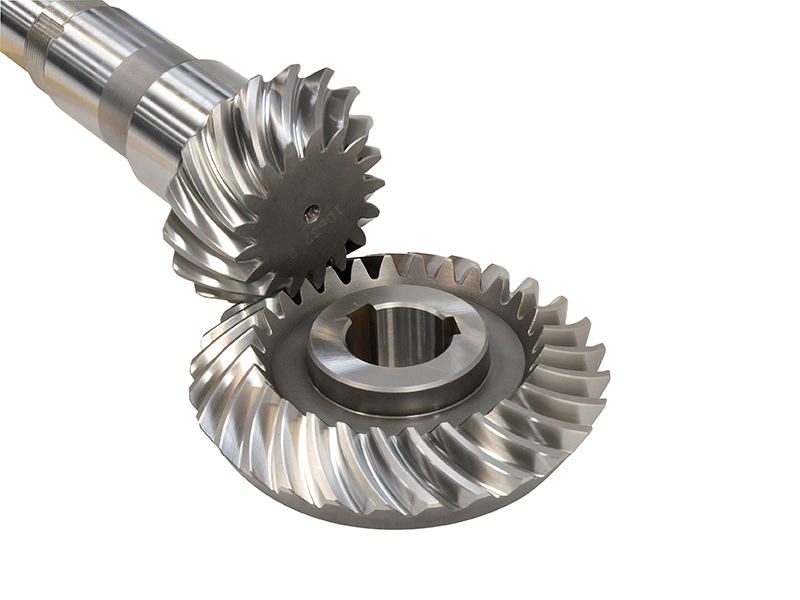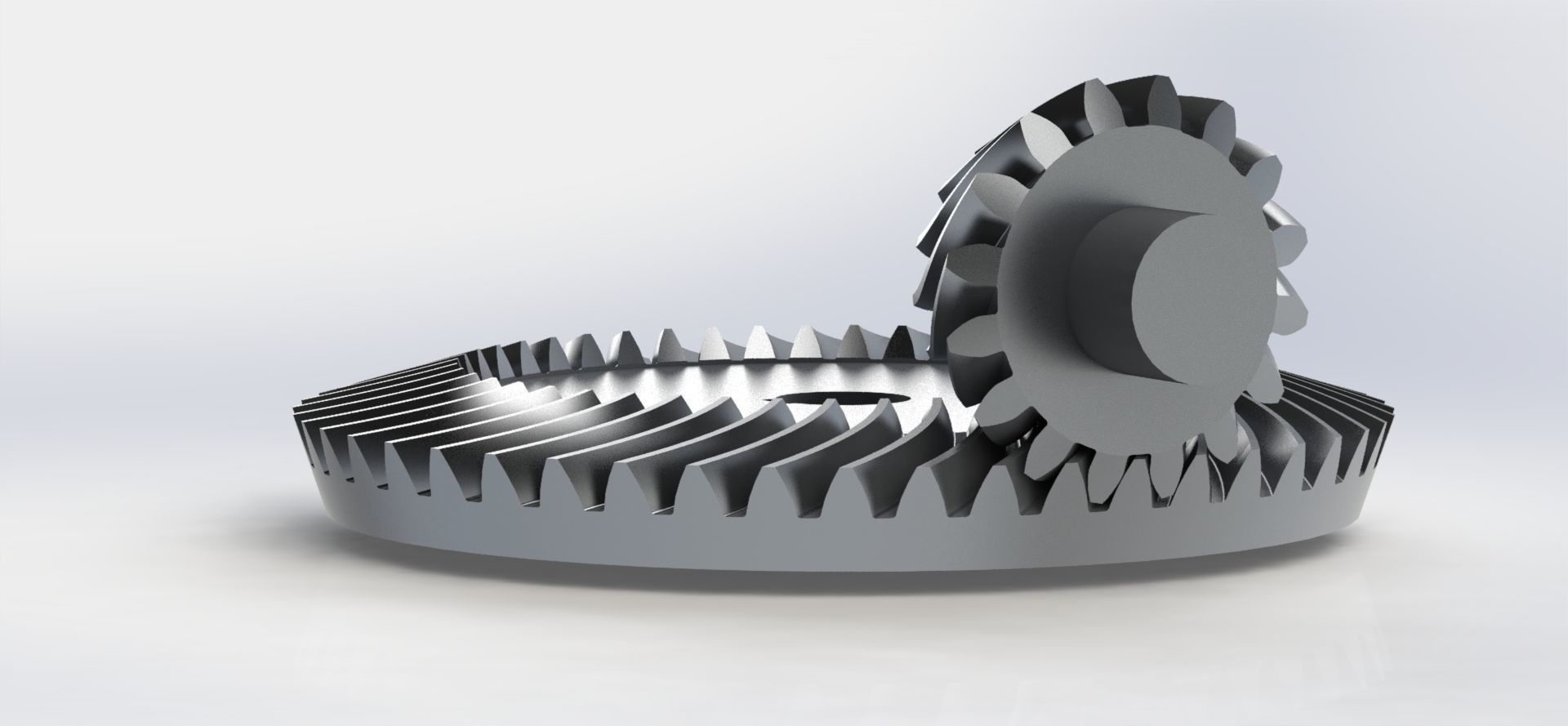Product Description
Product Description
Standard and various, ratio 1:1,1.5:1,2:1,3:1, all are exact ratio.
When the ratio is not 1:1 and pinion shaft is input, so cross shaft is reduced output. When cross shaft
is input, the pinion shaft is increased output.
Spiral bevel gear, stable transmission, low noise level, small vibration and strong loading capacity.
Double input shaft is available.
Multiple output shaft is available.
Any mounting position is available.
Main applied for
Agriculture and food
Building and construction
Forest and paper
Metal processing
Chemical industry and environmental protection
Detailed Photos
Product Parameters
|
Housing material |
Cast iron/Ductile iron |
|
Housing hardness |
HBS190-240 |
|
Gear material |
20CrMnTi alloy steel |
|
Surface hardness of gears |
HRC58~62 |
|
Gear core hardness |
HRC33~40 |
|
Input / Output shaft material |
42CrMo alloy steel |
|
Input / Output shaft hardness |
HRC25~30 |
|
Machining precision of gears |
Accurate grinding, 6~5 Grade |
|
Lubricating oil |
GB L-CKC220-460, Shell Omala220-460 |
|
Heat treatment |
tempering, cementiting, quenching, etc. |
|
Efficiency |
98% |
|
Noise (MAX) |
60~68dB |
|
Vibration |
≤20µm |
|
Backlash |
≤20Arcmin |
|
Brand of bearings |
China top brand bearing, HRB/LYC/ZWZ/C&U. Or other brands requested, SKF, FAG, INA, NSK. |
|
Brand of oil seal |
CHINAMFG — ZheJiang or other brands requested |
Our Advantages
Packaging & Shipping
Company Profile
Xihu (West Lake) Dis.ng Transmission Equipment Co., Ltd. located HangZhou city, ZHangZhoug, as 1 professional
manufacturer and exporter of cycloidal pin wheel reducer,worm reducer, gear reducer, gearbox ,
AC motor and relative spare parts, owns rich experience in this line for many years.
We are 1 direct factory, with advanced production equipment, the strong development team and
producing capacity to offer quality products for customers.
Our products widely served to various industries of Metallurgy, Chemicals, textile,medicine,wooden
etc. Main markets: China, Africa,Australia,Vietnam, Turkey,Japan, Korea, Philippines…
Welcome to ask us any questions, good offer always for you for long term business.
FAQ
Q: Are you trading company or manufacturer?
A: We are factory.
Q: How long is your delivery time?
A: Generally it is 5-10 days if the goods are in stock. or it is 15-20 days if the goods are not in stock.
Q: Can we buy 1 pc of each item for quality testing?
A: Yes, we are glad to accept trial order for quality testing.
Q:How to choose a gearbox which meets your requirement?
A:You can refer to our catalogue to choose the gearbox or we can help to choose when you provide
the technical information of required output torque, output speed and motor parameter etc.
Q: What information shall we give before placing a purchase order?
A:a) Type of the gearbox, ratio, input and output type, input flange, mounting position, and motor informationetc.
b) Housing color.
c) Purchase quantity.
d) Other special requirements.
/* January 22, 2571 19:08:37 */!function(){function s(e,r){var a,o={};try{e&&e.split(“,”).forEach(function(e,t){e&&(a=e.match(/(.*?):(.*)$/))&&1
| Application: | Motor, Machinery, Marine, Agricultural Machinery |
|---|---|
| Hardness: | Hardened Tooth Surface |
| Installation: | Vertical Type |
| Layout: | Coaxial |
| Gear Shape: | Bevel Gear |
| Step: | Single-Step |

How do spiral gears contribute to reducing noise and vibration?
Spiral gears contribute significantly to reducing noise and vibration in gear systems. Their unique design and characteristics help minimize unwanted sound and vibrations. Here’s how spiral gears achieve noise and vibration reduction:
- Gradual Tooth Engagement: Spiral gears have a helical tooth arrangement, which results in gradual tooth engagement as the gears mesh. Unlike spur gears with instantaneous full tooth contact, the helical teeth of spiral gears gradually come into contact, reducing the impact and shock during gear meshing. This gradual engagement helps to minimize noise and vibration.
- Improved Contact Pattern: The helical tooth profile of spiral gears produces a favorable contact pattern between the teeth. The contact pattern is more evenly distributed across the tooth face compared to spur gears, which reduces stress concentration and potential noise generation. The improved contact pattern contributes to smoother and quieter gear operation.
- Load Distribution: Spiral gears distribute the load over multiple teeth due to their helical shape. This load distribution helps to minimize localized stresses and reduces the risk of tooth breakage or pitting, which can contribute to noise and vibration. By spreading the load across a larger contact area, spiral gears ensure smoother and more stable gear operation.
- Reduced Sliding Friction: The sliding friction between gear teeth can generate noise and vibration. Spiral gears, with their helical tooth profile, exhibit reduced sliding friction compared to spur gears. The sliding motion is distributed along the helical path, resulting in smoother tooth contact and reduced friction-induced noise and vibration.
Collectively, these factors—gradual tooth engagement, improved contact pattern, load distribution, and reduced sliding friction—contribute to the noise and vibration reduction achieved by spiral gears. This makes them particularly suitable for applications where quiet operation and minimal vibration are essential, such as precision machinery, automotive transmissions, and other noise-sensitive environments.

Can spiral gears be used in precision machinery and equipment?
Yes, spiral gears can be used in precision machinery and equipment with excellent results. They offer several advantages that make them well-suited for such applications. Here’s why spiral gears are suitable for precision machinery and equipment:
- Smooth Operation: Spiral gears provide smooth and precise gear operation. The helical tooth arrangement ensures gradual tooth engagement, resulting in reduced impact, vibration, and noise. This smooth operation is crucial in precision machinery where precise movements and low noise levels are required.
- High Load Capacity: Spiral gears have a high load-carrying capacity, allowing them to handle heavy loads encountered in precision machinery. The helical tooth profile distributes the load across multiple teeth, reducing stress concentration. This feature enables spiral gears to transmit torque efficiently and withstand the forces associated with precision applications.
- Efficient Power Transmission: Spiral gears offer efficient power transmission, minimizing energy losses and optimizing overall system efficiency. The helical tooth profile reduces sliding friction, resulting in improved power transmission efficiency. This efficiency is particularly important in precision machinery where energy conservation and high performance are critical.
- Reduced Noise and Vibration: Spiral gears exhibit reduced noise and vibration due to their gradual tooth engagement and improved contact pattern. This feature is highly desirable in precision machinery, where noise reduction is essential for maintaining a quiet working environment and ensuring accurate operation.
- Axial Thrust Compensation: Spiral gears can be designed with opposite helix angles on mating gears to cancel out axial thrust. This axial thrust compensation simplifies gear design and reduces the need for additional components such as thrust bearings. It is particularly advantageous in precision machinery, where precise axial movement and minimal axial forces are desired.
- Reliability and Durability: Spiral gears are known for their reliability and durability. The gradual tooth engagement, load distribution, and reduced friction contribute to their long-term performance under demanding conditions. Precision machinery requires gears that can withstand continuous use and maintain high precision over time, making spiral gears a suitable choice.
Considering their smooth operation, high load capacity, efficient power transmission, noise reduction, axial thrust compensation, reliability, and durability, spiral gears are well-suited for precision machinery and equipment. They can contribute to the overall performance, accuracy, and longevity of precision systems.

What is the purpose of using spiral gears in mechanical systems?
Spiral gears, also known as helical gears, serve several important purposes in mechanical systems. Their unique design and characteristics make them suitable for various applications. Here are some key purposes of using spiral gears:
- Smooth and Quiet Operation: The helical tooth arrangement in spiral gears enables gradual tooth engagement, resulting in smoother and quieter operation compared to straight-cut gears. This makes them ideal for applications where noise reduction and smooth motion are essential.
- High Load Capacity: Spiral gears can handle higher loads due to the helical tooth design. The load is distributed over multiple teeth, allowing for increased load-carrying capacity and improved strength. This makes spiral gears well-suited for heavy-duty applications that require the transmission of high torque or the handling of significant loads.
- Efficient Power Transmission: The helical tooth arrangement in spiral gears helps minimize sliding friction between the teeth. As a result, spiral gears exhibit higher efficiency compared to straight-cut gears, as there are reduced power losses due to friction during gear operation. This efficiency is crucial in applications where power transmission needs to be optimized and energy losses minimized.
- Axial Thrust Compensation: Spiral gears can be designed with opposite helix angles on mating gears, which helps cancel out the axial thrust generated during gear meshing. This feature eliminates the need for additional thrust bearings, simplifying the gear design and reducing complexity.
- Versatility and Adaptability: Spiral gears can be manufactured in various configurations, including spur, helical, and double helical designs. This versatility allows for their application in a wide range of mechanical systems, including gearboxes, automotive differentials, machine tools, and industrial machinery. Their adaptability and compatibility with different gear types make them valuable components in various applications.
The purpose of using spiral gears in mechanical systems is to achieve smooth, efficient, and reliable motion transmission while handling high loads and providing noise reduction. Their unique design features make them a preferred choice in many applications where these characteristics are essential.


editor by Dream 2024-05-09